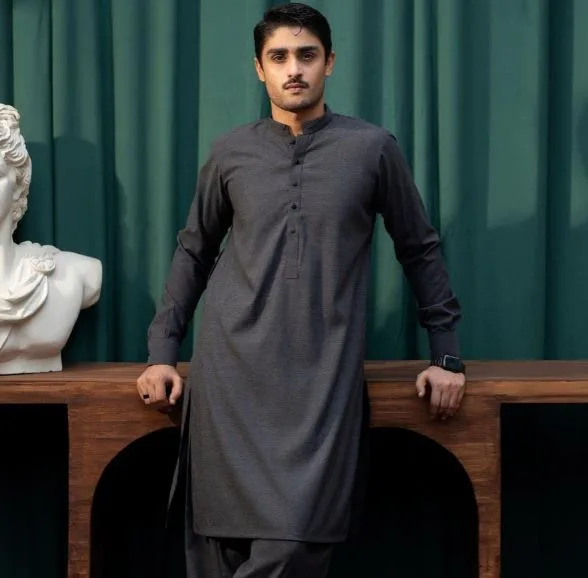Exploring the Rich Heritage of Pakistani Clothing
The vibrant culture and rich history of Pakistan are beautifully reflected in its traditional clothing. From the intricate patterns to the colorful fabrics, Pakistani clothing is a celebration of the nation’s diverse ethnicities and traditions. This article delves into the fascinating world of Pakistani clothing, exploring its significance, variety, and the cultural heritage it represents.
Pakistani clothing is deeply rooted in the country’s history and culture. It is an expression of identity and a symbol of pride for its people. The traditional attire is not just about aesthetics; it is a reflection of the region’s social norms, climate, and lifestyle.
A Blend of Cultures
Pakistan is a melting pot of cultures, and this diversity is evident in its clothing. The traditional outfits vary significantly across different regions, influenced by local customs and traditions. From the vibrant Sindhi attire to the elegant Punjabi suits, each region boasts its unique style of dress that contributes to the rich tapestry of Pakistani ethnic wear.
In the province of Sindh, for example, the traditional Ajrak and Sindhi caps are emblematic of the local culture. Ajrak, a block-printed cloth often in rich hues of red and indigo, holds great cultural significance and is used in both everyday wear and ceremonial occasions. The intricate patterns on Ajrak reflect ancient techniques passed down through generations.
In contrast, the Balochi dress, adorned with heavy embroidery and mirror work, reflects the nomadic lifestyle and resourcefulness of the Baloch people. Each stitch tells a story of resilience and cultural pride, with color palettes inspired by the desert landscapes of Balochistan.
The Role of Climate
The climate of Pakistan plays a significant role in determining the types of fabrics and clothing styles. In the hot and arid regions, lightweight and breathable fabrics such as cotton are preferred, while in the cooler northern areas, wool and thicker materials are common. This adaptation ensures comfort while maintaining the traditional aesthetics of Pakistani dresses.
In the sweltering heat of Punjab and Sindh, light-colored cotton garments help in staying cool and comfortable. The use of natural dyes and breathable fabrics is a traditional practice that continues to be relevant today. Conversely, in the northern areas, such as Gilgit-Baltistan, where temperatures can drop significantly, warm woolen shawls and heavy coats are essential components of traditional attire.
The seasonal variations in clothing also reflect the agricultural cycles and festivals. For instance, during the harvest festivals like Baisakhi in Punjab, brightly colored and embellished outfits are worn to celebrate the bounty of the land, showcasing a harmonious blend of practicality and festivity.
Social Norms and Traditional Attire
Pakistani clothing is not merely a fashion statement but a reflection of social norms and values. Modesty is a key aspect, with garments designed to cover the body while allowing freedom of movement. This is evident in the widespread use of the Dupatta, a versatile scarf that is both functional and decorative.
In rural areas, where traditional lifestyles prevail, the attire is closely linked to social status and tribal affiliations. Each tribe and community has its distinctive patterns and colors, which serve as identifiers and are often worn with pride during social gatherings and ceremonies.
The evolution of traditional clothing also mirrors the country’s historical interactions, from the Mughal influences seen in the ornate embellishments to the British colonial impact on tailoring techniques. This dynamic interplay of influences has created a unique sartorial identity that continues to evolve while honoring its roots.
Traditional Pakistani Dresses
Pakistani clothing is renowned for its variety and elegance. Traditional dresses are not only worn during special occasions but are also a part of everyday life. Some of the most popular traditional Pakistani dresses include:
Shalwar Kameez
The Shalwar Kameez is the national dress of Pakistan and is worn by both men and women. It consists of a long tunic, the kameez, paired with loose-fitting trousers known as shalwar. This outfit is celebrated for its comfort and versatility, making it a staple in every Pakistani wardrobe. Women often accessorize it with a colorful scarf or dupatta.
The Shalwar Kameez is often tailored to suit the occasion, with everyday versions being simple and practical, while those for formal events are adorned with elaborate embroidery and embellishments. The versatility of this ensemble allows for a wide range of fabrics and colors, ensuring its place as an enduring symbol of Pakistani culture.
In urban areas, contemporary versions of the Shalwar Kameez incorporate modern cuts and styles, appealing to the younger demographic. Designers experiment with asymmetrical hems, innovative sleeves, and fusion fabrics, creating a bridge between tradition and modernity.
Lehenga
The Lehenga is a traditional skirt that is often worn during weddings and festive occasions. It is a long, flowing skirt that is usually heavily embellished with embroidery, sequins, and beads. The Lehenga is paired with a fitted blouse and a dupatta, creating a stunning and regal look.
Lehengas are a staple in bridal trousseaus, with each piece meticulously crafted to reflect the bride’s personal style and regional heritage. The choice of colors, patterns, and embellishments often symbolizes cultural traditions and familial significance.
In recent years, the Lehenga has seen a resurgence in popularity, with designers reimagining this classic attire for contemporary tastes. The incorporation of unconventional colors, minimalist embroidery, and alternative fabrics has made the Lehenga a versatile choice for both traditional and modern brides.
Kurta
The Kurta is another popular piece of clothing that is worn by both men and women. It is a long shirt that can be worn with a shalwar or trousers. Kurtas are often adorned with intricate embroidery and can be made from a variety of fabrics, making them suitable for both casual and formal occasions.
The adaptability of the Kurta makes it a favored choice for daily wear and festive occasions alike. It can be paired with jeans or traditional bottoms, catering to diverse fashion preferences. The intricate embroidery and embellishments on Kurtas vary by region, showcasing the unique artistic styles of different communities.
In men’s fashion, the Kurta is often worn with a waistcoat or a traditional vest, adding an element of formality and sophistication. This combination is popular during cultural events and religious gatherings, symbolizing a deep respect for tradition and heritage.
Dupatta
The Dupatta is a long scarf that is an essential part of a woman’s attire in Pakistan. It is draped over the shoulders or head and is often matched with the color of the outfit. The Dupatta adds a touch of elegance and grace to the overall look.
Beyond its aesthetic appeal, the Dupatta serves practical purposes, providing modesty and protection from the elements. Its versatility allows it to be styled in numerous ways, from intricate drapes for formal occasions to simple folds for everyday wear.
The Dupatta also holds cultural and religious significance, often used in rituals and ceremonies. Its presence in a woman’s wardrobe is indispensable, symbolizing femininity and respect for cultural values. Fashion designers continue to innovate with Dupatta designs, incorporating prints, tassels, and embroidery to create contemporary interpretations of this timeless accessory.
Cultural Significance of Pakistani Dresses
by Le Tia (https://unsplash.com/@basinati)
Pakistani clothing is not just about fashion; it carries deep cultural significance. Each piece of traditional attire tells a story and represents the heritage of the region. The intricate embroidery and vibrant colors are a testament to the craftsmanship and artistry that have been passed down through generations.
Symbol of Identity
For many Pakistanis, traditional clothing is a symbol of their identity and cultural heritage. Wearing these outfits is a way to connect with their roots and express pride in their culture. It is also a way to celebrate important milestones and occasions, such as weddings, religious festivals, and cultural events.
Traditional attire often acts as a bridge between generations, with older family members sharing stories and meanings behind specific garments and patterns. This intergenerational exchange fosters a sense of belonging and continuity within families, ensuring that cultural values are upheld.
The symbolism of traditional clothing extends to regional pride, with individuals proudly donning garments that reflect their ethnic backgrounds. Whether it’s the vibrant hues of a Pathani suit or the intricate needlework of a Sindhi dress, each piece serves as a badge of honor, representing the wearer’s heritage.
Preservation of Tradition
In an ever-evolving world, traditional Pakistani clothing serves as a reminder of the country’s rich history and traditions. It is a way to preserve the cultural heritage and pass it on to future generations. Fashion designers in Pakistan are also playing a crucial role in keeping these traditions alive by incorporating traditional elements into modern designs.
The preservation of traditional clothing is not limited to rural areas; urban centers also embrace these styles, often reinterpreting them for contemporary lifestyles. This revival of traditional fashion is celebrated in events such as fashion weeks and cultural festivals, which showcase the richness and diversity of Pakistani attire.
Educational institutions and cultural organizations are also pivotal in promoting traditional clothing, organizing workshops and exhibitions that highlight the intricate techniques and historical significance of these garments. This collective effort ensures that the legacy of Pakistani clothing endures, inspiring future generations to cherish their cultural roots.
Artistry and Craftsmanship
The artistry involved in creating traditional Pakistani clothing is a testament to the skill and dedication of artisans across the country. Techniques such as hand embroidery, block printing, and weaving are passed down through generations, preserving the unique craftsmanship that sets Pakistani attire apart.
Each region boasts its distinctive style of embroidery, from the intricate Phulkari of Punjab to the mirror work of Sindh. These techniques require precision and creativity, with artisans often spending weeks or months crafting a single garment. The resulting pieces are not just clothing but works of art, reflecting the cultural richness and diversity of Pakistan.
As global interest in sustainable and ethically produced fashion grows, the craftsmanship of Pakistani clothing has gained international recognition. The emphasis on hand-made, artisanal products aligns with the global shift towards conscious consumerism, positioning Pakistani fashion as both culturally significant and environmentally responsible.
Modern Influences on Pakistani Clothing
While traditional Pakistani clothing remains popular, modern influences have also made their mark. Fashion designers are blending traditional styles with contemporary trends, creating unique and stylish outfits that appeal to the younger generation.
Fusion of Styles
The fusion of traditional and modern styles has given rise to a new era of Pakistani fashion. Designers are experimenting with cuts, fabrics, and embellishments to create outfits that are both trendy and culturally significant. This fusion is not only popular in Pakistan but has also gained international recognition.
Contemporary designers are pushing the boundaries of traditional fashion, incorporating elements such as Western silhouettes, digital prints, and minimalist aesthetics into traditional garments. This creative fusion results in innovative designs that resonate with a global audience, appealing to diverse fashion sensibilities.
Collaborations between traditional artisans and modern designers further enrich this fusion, with craftsmen bringing their expertise to contemporary designs. This partnership not only revitalizes traditional crafts but also introduces them to new markets, ensuring their sustainability and relevance in today’s fashion landscape.
Global Appeal
Pakistani clothing has gained a global audience, with many international fashion shows featuring Pakistani designers. The intricate designs, luxurious fabrics, and vibrant colors have captivated fashion enthusiasts worldwide, putting Pakistani fashion on the global map.
The global appeal of Pakistani fashion is evident in its presence at prestigious events such as Paris Fashion Week and the Dubai Fashion Festival. International buyers and fashion influencers are drawn to the unique blend of tradition and modernity that Pakistani designers offer, showcasing the versatility and creativity of the country’s fashion industry.
Social media platforms have also played a significant role in amplifying the reach of Pakistani fashion. Influencers and fashion bloggers worldwide showcase Pakistani designs, introducing them to a broader audience and fostering cross-cultural appreciation.
Technology and Innovation
The integration of technology in the fashion industry has opened new avenues for Pakistani designers. Digital tools and platforms have revolutionized the design process, enabling designers to experiment with new techniques and reach global audiences effortlessly.
Virtual fashion shows and online retail platforms have made Pakistani clothing accessible to international consumers, expanding the market for traditional and contemporary designs. Designers are also utilizing technology to create sustainable fashion solutions, incorporating eco-friendly materials and ethical production practices into their collections.
This technological advancement has not only enhanced the visibility of Pakistani fashion but also positioned it as a forward-thinking industry that embraces innovation while honoring tradition.
Conclusion
Pakistani clothing is a beautiful reflection of the country’s rich heritage and diverse culture. From traditional attire like the Shalwar Kameez to modern fusion styles, Pakistani dresses are a celebration of craftsmanship and artistry. As the fashion industry continues to evolve, the timeless elegance and cultural significance of Pakistani clothing ensure that it remains an integral part of the nation’s identity for generations to come.
The enduring appeal of Pakistani clothing lies in its ability to adapt to changing times while preserving its cultural essence. As designers continue to innovate and explore new horizons, Pakistani fashion will undoubtedly continue to captivate and inspire, both within its borders and beyond. This rich sartorial heritage serves as a testament to the creativity, resilience, and cultural pride of the Pakistani people, ensuring its place on the global fashion stage for years to come.







